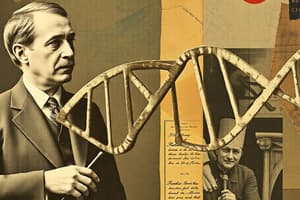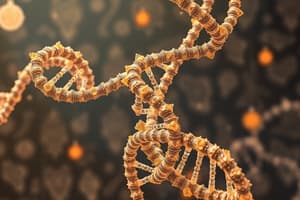Podcast
Questions and Answers
What primary field did Francis Crick study before shifting to biology?
What primary field did Francis Crick study before shifting to biology?
- Electrical Engineering
- Medicine
- Physics (correct)
- Chemistry
In what year did Crick and Watson publish their findings on DNA's structure?
In what year did Crick and Watson publish their findings on DNA's structure?
- 1962
- 1953 (correct)
- 1952
- 1954
What significant transition did Crick make in his career in 1976?
What significant transition did Crick make in his career in 1976?
- He moved into neurobiology and consciousness studies. (correct)
- He became a Nobel laureate.
- He returned to physics research.
- He retired from all scientific pursuits.
What major scientific advance does Crick's quote refer to?
What major scientific advance does Crick's quote refer to?
What position was Crick appointed to in 1977?
What position was Crick appointed to in 1977?
What year did James Watson complete his PhD in virus research?
What year did James Watson complete his PhD in virus research?
Which significant scientific project did James Watson lead in 1989?
Which significant scientific project did James Watson lead in 1989?
At which institution did Watson conduct research on viruses in the 1950s?
At which institution did Watson conduct research on viruses in the 1950s?
With whom did James Watson collaborate to publish groundbreaking research on DNA structure?
With whom did James Watson collaborate to publish groundbreaking research on DNA structure?
What was one of James Watson's contributions to academia besides his research?
What was one of James Watson's contributions to academia besides his research?
What did Crick and Watson's discovery of DNA primarily contribute to the field of genetics?
What did Crick and Watson's discovery of DNA primarily contribute to the field of genetics?
Which significant step in the DNA research timeline occurred first?
Which significant step in the DNA research timeline occurred first?
How did the discovery of DNA's structure impact scientific research?
How did the discovery of DNA's structure impact scientific research?
What was a notable collaboration in the race to understand DNA's structure?
What was a notable collaboration in the race to understand DNA's structure?
Which statement best reflects the nature of DNA's role in living organisms?
Which statement best reflects the nature of DNA's role in living organisms?
Which two scientists are credited with the discovery of the DNA structure?
Which two scientists are credited with the discovery of the DNA structure?
What was the primary method used by Rosalind Franklin that contributed to the DNA discovery?
What was the primary method used by Rosalind Franklin that contributed to the DNA discovery?
What chemical bases compose DNA, excluding any additional components?
What chemical bases compose DNA, excluding any additional components?
How long did it take Crick and Watson to build the final DNA model?
How long did it take Crick and Watson to build the final DNA model?
Which statement accurately summarizes the collaborative effort of Crick and Watson in discovering DNA's structure?
Which statement accurately summarizes the collaborative effort of Crick and Watson in discovering DNA's structure?
Flashcards are hidden until you start studying
Study Notes
Francis Crick
- British biophysicist, Nobel Prize winner in 1962 for discovering DNA structure with James Watson in 1953
- Initially studied physics, then joined the Royal Navy during WWII
- After the war, transitioned to biology and joined the Cavendish Laboratory in Cambridge in 1949
- Met James Watson in 1951 at the Cavendish Laboratory, initiating their groundbreaking collaboration
- Used X-ray diffraction and model building to unravel the double helix structure of DNA
- Their 1953 publication in Nature revolutionized understanding of genetics
- Continued research, contributing significantly to deciphering the genetic code
- Moved to California in 1976 to focus on neurobiology and consciousness studies
- Appointed Professor at the Salk Institute for Biological Studies in 1977
- "The genetic code is...the key to molecular biology" - Francis Crick (1966)
James Watson
- US geneticist and biophysicist, co-discovered the double helix structure of DNA with Francis Crick
- Received a Nobel Prize for his contribution
- Earned a degree in zoology at the University of Chicago in 1947
- Completed his PhD in virus research in 1950
- Joined the Cavendish Laboratory in Cambridge in 1951, where he collaborated with Francis Crick
- Published groundbreaking research on DNA structure with Crick in 1953
- Became a professor of biology at Harvard in 1960
- Led the international Human Genome Project in 1989, aiming to map human genes
- "In science there is only one answer and that has to be correct." - James Watson (1987)
DNA: A Revolutionary Discovery
- Crick and Watson's discovery of the double helix structure of DNA was a significant scientific achievement in the 20th century
- DNA (deoxyribonucleic acid) is the chemical substance within cells that determines hereditary patterns in all living organisms
- Understanding DNA's structure provided insights into its replication, transmission of genetic information, and gene function
- The "race to understand DNA" involved various scientists globally, starting before Crick and Watson's collaboration
- Oswald Avery identified DNA as the carrier of genetic information in 1944, but its structure remained unknown until 1953
- The discovery of DNA's structure led to advancements in gene sequencing and genetic engineering, opening new research avenues for understanding inherited medical conditions
The Discovery of DNA Structure
- Linus Pauling (US chemist), Rosalind Franklin, Maurice Wilkins (both worked at King's College London), and Sydney Brenner (South African biologist) were all key players in the discovery process
- DNA structure is composed of a backbone and four chemical bases: adenine (A), thymine (T), guanine (G), and cytosine (C)
- Crick and Watson's success was driven by their single-minded focus, combining evidence and disciplines like genetics, physics, and X-ray crystallography
- They focused on building 3D models rather than lengthy experiments
- Their breakthrough was aided by reviewing data from Rosalind Franklin
- The discovery, published in a single-page paper, was the outcome of 18 months of research and 3 days of building the DNA model
- "We have discovered the secret of life" - Francis Crick (1953)
Studying That Suits You
Use AI to generate personalized quizzes and flashcards to suit your learning preferences.





